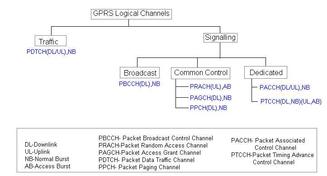GSM vs. GPRS: Understanding the Key Differences
Advertisement
This article highlights the differences between GSM (Global System for Mobile Communications) and GPRS (General Packet Radio Service) technologies. While they share some similarities, they cater to different needs and operate in distinct ways.
Core Similarities
- Air Interface: Both GSM and GPRS utilize the same underlying air interface: TDMA/FDMA (Time Division Multiple Access/Frequency Division Multiple Access).
Key Differences
-
Timeslot Allocation:
- GPRS: Allocates multiple timeslots to a single User Equipment (UE).
- GSM: Allocates one timeslot to one UE.
-
Multiframe Structure:
- GSM: Uses different multiframe structures for signaling (51-frame MF) and traffic (26-frame MF).
- GPRS: Employs a common 52-frame MF structure for both signaling and traffic. This 52 Multiframe is composed of 12 radio blocks, two idle slots, and two slots for PTCCH (Packet Timing Advance Control Channel), which is used for timing advance purposes. Each Radio Block spans over 4 consecutive TDMA frames of one time slot.
-
Synchronization:
- GPRS: Synchronizes using BCCH (Broadcast Control Channel), eliminating the need for FCCH/SCH (Frequency Correction Channel/Synchronization Channel) used in GSM.
- GSM: Relies on FCCH/SCH for synchronization. GPRS may utilize PBCCH (Packet Broadcast Control Channel) for GPRS-specific System Information (SIs), but its use is optional.
-
Common Control Channels:
- Both GSM and GPRS share similar common control channels: PRACH (Packet Random Access Channel) to RACH (Random Access Channel), PAGCH (Packet Access Grant Channel) to AGCH (Access Grant Channel), and PPCH (Packet Paging Channel) to PCH (Paging Channel).
-
Traffic Type:
- GSM: Primarily used for circuit-switched traffic, mainly voice calls.
- GPRS: Designed for packet-switched traffic, such as internet access and MMS (Multimedia Messaging Service). Due to this, PDTCH (Packet Data Traffic Channel) is allocated on demand in GPRS, contrasting with the static nature of TCH (Traffic Channel) in GSM.
-
Control Channels SACCH/FACCH vs. PTCCH/PACCH:
- GSM: Utilizes SACCH (Slow Associated Control Channel) and FACCH (Fast Associated Control Channel).
- GPRS: Replaces these with PTCCH (Packet Timing Advance Control Channel) for timing advance and PACCH (Packet Associated Control Channel) for other signaling functions.
-
Timeslot Usage:
- GPRS: Allows multiple UEs to use the same timeslot at different times, each identified by unique downlink (TFI - Temporary Flow Identity) and uplink (USF - Uplink State Flag) identifiers.
- GSM: Timeslots are dedicatedly reserved for specific UEs until released.
-
Resource Allocation:
- GSM: Employs symmetric allocation, where a timeslot is allocated in both uplink and downlink directions.
- GPRS: Uses asymmetric allocation, enabling allocation of timeslots only in downlink (e.g., when a user is only downloading data) without requiring an uplink timeslot.
-
Location/Routing:
- GSM: Uses the concept of “location areas.”
- GPRS: Uses the concept of “routing areas.”
-
UE States:
- GSM: Mobile devices (UEs) exist in two states: IDLE and READY.
- GPRS: UEs can be in three states: IDLE, STANDBY, and READY.
-
Paging:
- GPRS: Requires more frequent transmission on the paging channel due to the bursty nature of packet traffic compared to GSM.
-
Network Architecture:
- GPRS: Introduces additional network elements like PCU (Packet Control Unit), SGSN (Serving GPRS Support Node), and GGSN (Gateway GPRS Support Node) to the standard GSM architecture to support packet traffic. Additionally, channel coding units at the BTS (Base Transceiver Station) are upgraded to support various GPRS data rates.
- GSM: Relies on its existing architecture for circuit-switched operations.
For a more in-depth understanding, refer to dedicated GSM and GPRS architectural diagrams and documentation.
Advertisement
 RF
RF


